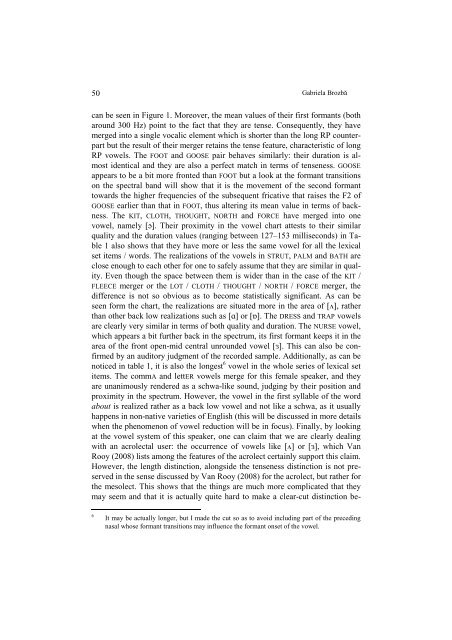s - Wyższa SzkoÅa Filologiczna we WrocÅawiu
s - Wyższa SzkoÅa Filologiczna we WrocÅawiu
s - Wyższa SzkoÅa Filologiczna we WrocÅawiu
Create successful ePaper yourself
Turn your PDF publications into a flip-book with our unique Google optimized e-Paper software.
50<br />
Gabriela Brozbă<br />
can be seen in Figure 1. Moreover, the mean values of their first formants (both<br />
around 300 Hz) point to the fact that they are tense. Consequently, they have<br />
merged into a single vocalic element which is shorter than the long RP counterpart<br />
but the result of their merger retains the tense feature, characteristic of long<br />
RP vo<strong>we</strong>ls. The FOOT and GOOSE pair behaves similarly: their duration is almost<br />
identical and they are also a perfect match in terms of tenseness. GOOSE<br />
appears to be a bit more fronted than FOOT but a look at the formant transitions<br />
on the spectral band will show that it is the movement of the second formant<br />
towards the higher frequencies of the subsequent fricative that raises the F2 of<br />
GOOSE earlier than that in FOOT, thus altering its mean value in terms of backness.<br />
The KIT, CLOTH, THOUGHT, NORTH and FORCE have merged into one<br />
vo<strong>we</strong>l, namely [ɔ]. Their proximity in the vo<strong>we</strong>l chart attests to their similar<br />
quality and the duration values (ranging bet<strong>we</strong>en 127–153 milliseconds) in Table<br />
1 also shows that they have more or less the same vo<strong>we</strong>l for all the lexical<br />
set items / words. The realizations of the vo<strong>we</strong>ls in STRUT, PALM and BATH are<br />
close enough to each other for one to safely assume that they are similar in quality.<br />
Even though the space bet<strong>we</strong>en them is wider than in the case of the KIT /<br />
FLEECE merger or the LOT / CLOTH / THOUGHT / NORTH / FORCE merger, the<br />
difference is not so obvious as to become statistically significant. As can be<br />
seen form the chart, the realizations are situated more in the area of [ʌ], rather<br />
than other back low realizations such as [ɑ] or [ɒ]. The DRESS and TRAP vo<strong>we</strong>ls<br />
are clearly very similar in terms of both quality and duration. The NURSE vo<strong>we</strong>l,<br />
which appears a bit further back in the spectrum, its first formant keeps it in the<br />
area of the front open-mid central unrounded vo<strong>we</strong>l [ɜ]. This can also be confirmed<br />
by an auditory judgment of the recorded sample. Additionally, as can be<br />
noticed in table 1, it is also the longest 6 vo<strong>we</strong>l in the whole series of lexical set<br />
items. The commA and lettER vo<strong>we</strong>ls merge for this female speaker, and they<br />
are unanimously rendered as a schwa-like sound, judging by their position and<br />
proximity in the spectrum. Ho<strong>we</strong>ver, the vo<strong>we</strong>l in the first syllable of the word<br />
about is realized rather as a back low vo<strong>we</strong>l and not like a schwa, as it usually<br />
happens in non-native varieties of English (this will be discussed in more details<br />
when the phenomenon of vo<strong>we</strong>l reduction will be in focus). Finally, by looking<br />
at the vo<strong>we</strong>l system of this speaker, one can claim that <strong>we</strong> are clearly dealing<br />
with an acrolectal user: the occurrence of vo<strong>we</strong>ls like [ʌ] or [ɜ], which Van<br />
Rooy (2008) lists among the features of the acrolect certainly support this claim.<br />
Ho<strong>we</strong>ver, the length distinction, alongside the tenseness distinction is not preserved<br />
in the sense discussed by Van Rooy (2008) for the acrolect, but rather for<br />
the mesolect. This shows that the things are much more complicated that they<br />
may seem and that it is actually quite hard to make a clear-cut distinction be-<br />
6<br />
It may be actually longer, but I made the cut so as to avoid including part of the preceding<br />
nasal whose formant transitions may influence the formant onset of the vo<strong>we</strong>l.
















